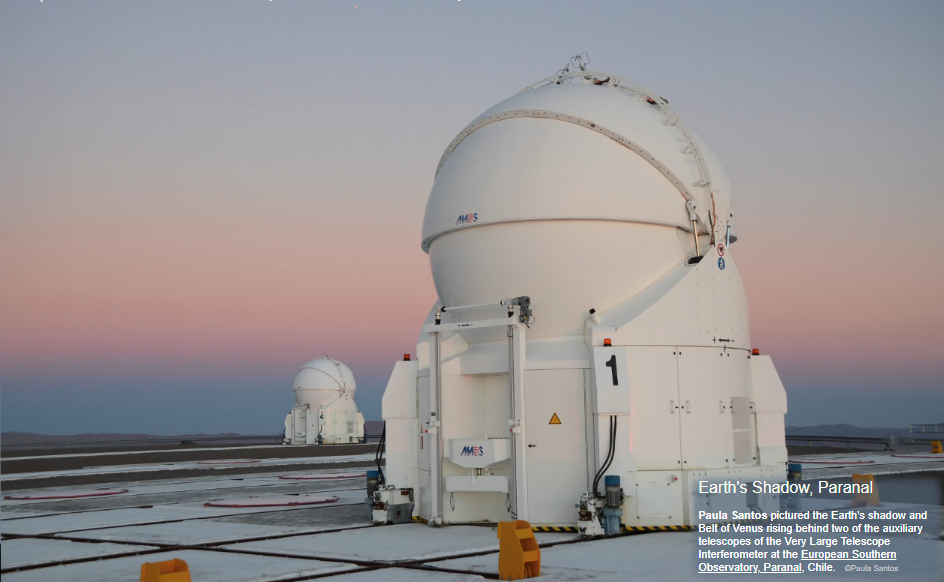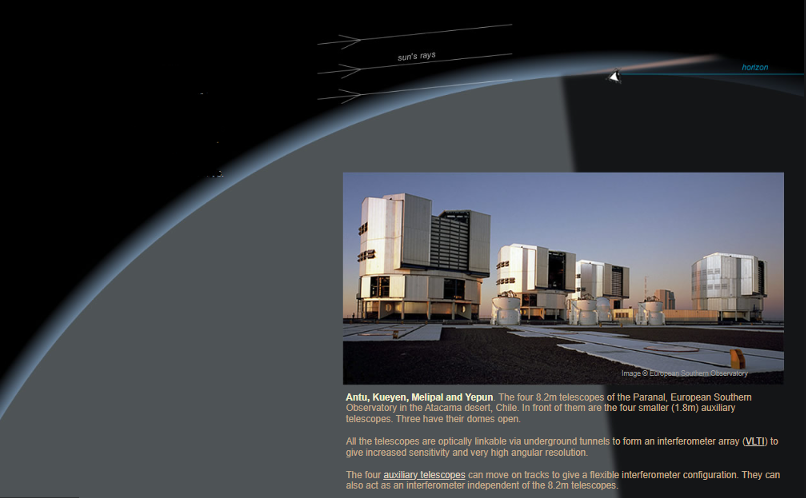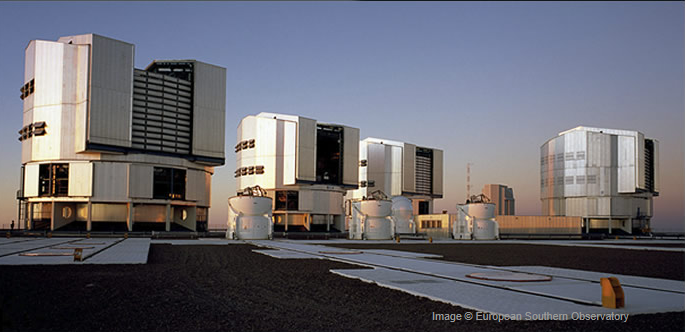OPOD - Earth's Shadow at Paranal Observatory
OPOD - Earth's Shadow at Paranal Observatory
When the sun sets and darkness begins to settle, a remarkable phenomenon unfolds along the eastern horizon at the Paranal Observatory in Chile. As the Earth's shadow rises, a band of dark purple hues emerges, casting an enchanting backdrop against the night sky. This ethereal spectacle, known as the Earth's Shadow, is a three-dimensional phenomenon that reveals the unlit atmosphere masked by the Earth's rim. At its upper edge, a delicate rosy pink glow emerges, giving birth to the mesmerizing Belt of Venus or Anti-twilight Arch.
The Earth's Shadow at Paranal Observatory offers a captivating display that captures the imagination of astronomers and stargazers alike. As the sun sets, its rays become progressively reddened by Rayleigh scattering, a phenomenon where sunlight interacts with air molecules in the Earth's atmosphere. The upper edge of the shadow, where the sun is just setting, showcases the most intense reddening of these rays. Here, the reddened light combines with scattered blue light from the atmosphere, resulting in the enchanting pink hues of the Belt of Venus.
At the Paranal Observatory, home to the European Southern Observatory's Very Large Telescope Interferometer (VLTI), this celestial phenomenon adds an extra layer of beauty to an already awe-inspiring setting. The observatory boasts four colossal 8.2-meter telescopes named Antu, Kueyen, Melipal, and Yepun, which are surrounded by four smaller 1.8-meter auxiliary telescopes. These telescopes can be linked together through underground tunnels to form the VLTI, creating an interferometer array that enhances sensitivity and provides exceptional angular resolution.
What sets the Paranal Observatory apart is not only its impressive collection of telescopes but also its versatility. The four auxiliary telescopes have the ability to move on tracks, allowing for flexible configurations as an interferometer. They can also operate independently of the 8.2-meter telescopes, further expanding the observatory's observational capabilities. This adaptability makes the Paranal Observatory a hub of scientific exploration, enabling researchers to delve into the mysteries of the universe with unprecedented precision.
The Paranal Observatory's location in the Atacama Desert in Chile offers ideal conditions for astronomical observations. The region is renowned for its dry climate and clear skies, providing minimal atmospheric interference and optimal visibility for astronomers. These factors, combined with the advanced technology and state-of-the-art facilities at Paranal, make it a prime location for cutting-edge research and groundbreaking discoveries.
As visitors gaze upon the Earth's Shadow at Paranal Observatory, they are not only treated to a visual feast but also reminded of the intricate interplay between light, atmosphere, and celestial bodies. This phenomenon serves as a reminder of the immense scale and beauty of the universe we inhabit. It invites contemplation and sparks curiosity about the mysteries that lie beyond our planet.
In conclusion, the Earth's Shadow at Paranal Observatory is a breathtaking natural spectacle that showcases the beauty and complexity of atmospheric optics. The interplay between the Earth's shadow, the Belt of Venus, and the state-of-the-art telescopes at Paranal Observatory creates a truly enchanting experience for astronomers and visitors alike. This captivating phenomenon serves as a reminder of the vastness and wonder of the universe, inspiring us to continue exploring and unraveling its secrets.

Earth's Shadow, Paranal
Paula Santos pictured the Earth's shadow and Belt of Venus rising behind two of the auxiliary telescopes of the Very Large Telescope Interferometer at the European Southern Observatory, Paranal, Chile. ©Paula Santos
Image

After sunset a dark purple hued band rises along the eastern horizon - the shadow of the Earth. Its upper edge is often suffused with a rosy pink glow - the Belt of Venus or Anti-twilight Arch.
The shadow is three dimensional and marks the unlit atmosphere masked from the sun's rays by the Earth's rim.
The upper edge of the shadow is where the sun is just setting and there its rays are most reddened by Rayleigh scattering. The reddened rays combine with scattered blue light from the atmosphere to give the pinks of the Belt of Venus.

Antu, Kueyen, Melipal and Yepun. The four 8.2m telescopes of the Paranal, European Southern Observatory in the Atacama desert, Chile. In front of them are the four smaller (1.8m) auxiliary telescopes. Three have their domes open.
All the telescopes are optically linkable via underground tunnels to form an interferometer array (VLTI) to give increased sensitivity and very high angular resolution.
The four auxiliary telescopes can move on tracks to give a flexible interferometer configuration. They can also act as an interferometer independent of the 8.2m telescopes.
Note: this article has been automatically converted from the old site and may not appear as intended. You can find the original article here.
Reference Atmospheric Optics
If you use any of the definitions, information, or data presented on Atmospheric Optics, please copy the link or reference below to properly credit us as the reference source. Thank you!
-
<a href="https://atoptics.co.uk/blog/opod-earths-shadow-at-paranal-observatory/">OPOD - Earth's Shadow at Paranal Observatory</a>
-
"OPOD - Earth's Shadow at Paranal Observatory". Atmospheric Optics. Accessed on December 25, 2024. https://atoptics.co.uk/blog/opod-earths-shadow-at-paranal-observatory/.
-
"OPOD - Earth's Shadow at Paranal Observatory". Atmospheric Optics, https://atoptics.co.uk/blog/opod-earths-shadow-at-paranal-observatory/. Accessed 25 December, 2024
-
OPOD - Earth's Shadow at Paranal Observatory. Atmospheric Optics. Retrieved from https://atoptics.co.uk/blog/opod-earths-shadow-at-paranal-observatory/.